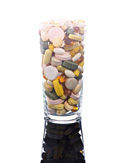Vitamins: What You Need to Know
What You Need to Know Now

You wake up and reach for your daily fix. One multi. An extra C. A couple of calcium chews. It's the healthy American way, right? About half the people in this country pop at least one supplement on a regular basis, and many don't stop there, gulping down carefully orchestrated handfuls of pills while shoring up their diets with fortified foods and beverages.
What seems to have gotten lost in the enthusiasm for vitamins is the fact that too much of a good thing can, indeed, be bad. Growing evidence that high doses of individual nutrients may be harmful prompted the Food and Nutrition Board to establish a new measurement called the tolerable upper intake level (UL): the maximum amount of a vitamin or mineral from your food and supplements combined that's considered safe on a long-term daily basis (for a few nutrients, the UL only refers to supplements). There isn't enough data to calculate exactly how likely you are to have an adverse reaction by consistently going over the UL, and experts say that for most nutrients the odds are extremely low. Still, the dangers are real enough to suggest caution.
Take a look at this tip sheet to find out if you're getting what you need—or too much of a good thing.
These RDAs are for women. Risks refer to levels you get from food and supplements combined, except where noted.
What seems to have gotten lost in the enthusiasm for vitamins is the fact that too much of a good thing can, indeed, be bad. Growing evidence that high doses of individual nutrients may be harmful prompted the Food and Nutrition Board to establish a new measurement called the tolerable upper intake level (UL): the maximum amount of a vitamin or mineral from your food and supplements combined that's considered safe on a long-term daily basis (for a few nutrients, the UL only refers to supplements). There isn't enough data to calculate exactly how likely you are to have an adverse reaction by consistently going over the UL, and experts say that for most nutrients the odds are extremely low. Still, the dangers are real enough to suggest caution.
Take a look at this tip sheet to find out if you're getting what you need—or too much of a good thing.
| Nutrient | RDA | UL | Risks of too much |
| Vitamin A | 700 mcg | 3,000 mcg | Liver abnormalitiies, birth defects, reduced bone density |
| Vitamin B6 | 1.3 mg; ages 51 and over, 1.5 mg | 100 mg | Nerve damage to the arms and legs (from very high intake of supplements) |
| Vitamin B12 | 2.4 mcg | None yet | No known dangers |
| Vitamin C | 75 mg | 2,000 mg | Nausea, cramps, diarrhea, kindey stones |
| Vitamin D | 5 mcg; ages 51-70, 10 mcg; over 10, 15 mcg | 50 mcg | High calcium levels in the blood |
| Vitamin E | 15 mg | 1,000 mg | Hemorrhage (only from supplements and fortified food) |
| Calcium | 1,000 mg; 51 and over, 1,200 mg | 2,500 mg | Kidney stones from supplements; renal insufficiency |
These RDAs are for women. Risks refer to levels you get from food and supplements combined, except where noted.



